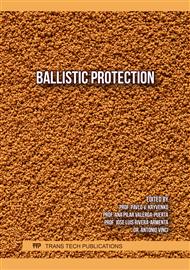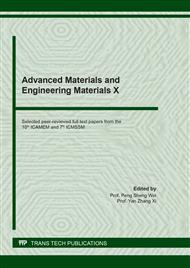[1]
DU Shan-yi, GUAN Zhi-dong, Strategic Considerations for Development of Advanced Composite Technology for Large Commercial Air-craft in China, Acta Material Compositae Sinica. 25 (1) 1-10.
Google Scholar
[2]
CHEN Shao-jie, Composite Structures for New Generation Large Commercial, Acta Aeronautica Et Astronautica Sinica. 29(3)605-610.
Google Scholar
[3]
Bhatnagar A, Lightweight Ballistic Composites Military and Law-Enforcement Applications, Abington Hall, Abington, Cambridge, (2006).
DOI: 10.1201/9781439824436.ch13
Google Scholar
[4]
Morye, S.S.; Hine, P.J.; Duckett, R.A.; Carr, D.J. & Ward, I.M, Modelling of energy absorbtion by polymer composites upon ballistic impact. Compos. Sci. Technol. 60(14)2631-42.
DOI: 10.1016/s0266-3538(00)00139-1
Google Scholar
[5]
Naik, N.K., Shrirao, P, Composite structures under ballistic impact, Composite Structures. 66(1-4)579-90.
DOI: 10.1016/j.compstruct.2004.05.006
Google Scholar
[6]
Michele Pasquali, Consuelo Terra, Paolo Gaudenzi, Analytical modelling of high-velocity impacts on thin woven fabric composite targets, Composite Structure.131(2015)951-965.
DOI: 10.1016/j.compstruct.2015.06.078
Google Scholar
[7]
Wen, H.M, Predicting the penetration and perforation of FRP laminates struck normally by projectiles with different nose shapes, Composite Structures. 49(3)321-329.
DOI: 10.1016/s0263-8223(00)00064-7
Google Scholar
[8]
Ganesh Babu, M., Velmurugan, R., Gupta, N.K., Energy absorption and ballistic limit of targets struck by heavy projectile, Lat. Am. J. Solids Struct.3(1) 21-39.
Google Scholar
[9]
Wang Y B, Wang X J, Hu X Z, WANG F. Experimental study of ballistic resistance of Kevlar laminates, Engineering mechanics.22(3)76-81.
Google Scholar
[10]
Sikarwar, R.S., Velmurugan, R., Madhu, V, Experimental and analytical study of high velocity impact on Kevlar/Epoxy composite plates,Cent. Eur. J. Eng.2(4)638-50.
DOI: 10.2478/s13531-012-0029-x
Google Scholar
[11]
Yahaya, R., S. M. Sapuan, M. Jawaid, Z. Leman, and E. S. Zainudin, Investigating ballistic impact properties of woven kenaf-aramid hybrid composites, Fibers & Polymers. 17(2)275-281.
DOI: 10.1007/s12221-016-5678-6
Google Scholar
[12]
Chen Fangyu, Zhou Li,Tang yihao & Zhou xiaoming, Analytical modeling of high-velocity impacts on woven kevlar composite laminates. Journal of measurements in engineering. 5(4)249-256.
DOI: 10.21595/jme.2017.19253
Google Scholar
[13]
Zhu, G., Goldsmith, W. , Dharan, C.H.K, Penetration of laminated kevlar by projectiles-II, Analytical model. Int. J. Solids Struct. 29(4)421-36.
DOI: 10.1016/0020-7683(92)90208-b
Google Scholar
[14]
Sun, C.T. & Potti, S.V, A simple model to predict residual velocity of thick composite laminates subjected to high velocity impact, Int. J. Impact Eng.18(3)339-53.
DOI: 10.1016/0734-743x(96)89053-1
Google Scholar
[15]
Wang W, Makarov G, Shenoi R A, An analytical model for assessing strain rate sensitivity of unidirectional composite laminates, Composite Structures.69(1)45-54.
DOI: 10.1016/j.compstruct.2004.04.017
Google Scholar
[16]
Cheng W L, Langlie S, Itoh S, High velocity impact of thick composites, International Journal of Impact Engineering. 29(1-10)167-184.
DOI: 10.1016/j.ijimpeng.2003.09.015
Google Scholar



